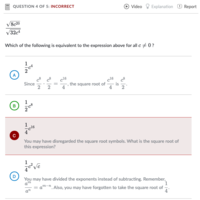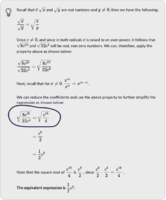potatojanitor
New member
- Joined
- Mar 17, 2021
- Messages
- 6
Hi all, I'm prepping for the SAT and I'm using Khan Academy SAT Prep to hone my math. I'm doing "Exponents and rational exponents" practice and I've run into a snag. I tried to answer but in the end I decided to guess, so I picked B. What I'm stuck with is the explanation. Specifically, the part where it simplified the expression, which I circled in the image. I don't understand how you can make the c in the denominator disappear like that. I know that when ab ÷ ac = a(b-c), but why is it gone? Is it because when c0 = 1? And 1 • 4 = 4? Even then, it seems flawed to do it like that. Is it because (8/32) • (c20/c4) = (1/4) • (c16/c0) = (1/4) • (c16/1)= (1/4) • c16 = c16/4? Or is it (8/32) • (c20/c4) = (1/4) • c(20 - 4) = (1/4) • c16 = c16/4? I use the parentheses to separate the thingys. Is this correct?




Last edited:
